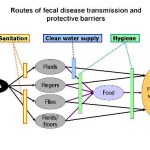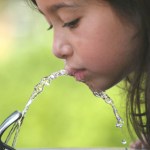water
A few of the recent pieces I've liked:
Ken Ward Jr. at Sustained Outrage: Protecting workers: Progress under Obama? (Also see his related Coal Tattoo piece on mine safety in the Obama administration)
Maryn McKenna at Superbug: What vaccine refusal really costs: Measles in Arizona
Body Horrors: Blood Money: Hookworm Economics in the Postbellum South
Shadowfax at Movin' Meat: Why Patients are Not Consumers (related: Paul Krugman's Patients are Not Consumers)
Tara C. Smith at Aetiology: Staph in food -- what does it mean?
David Rosenfeld at DC Bureau: California turns to Mexico for Cheap Water,…
While much of the Earth Week news coverage has dwelt on the lasting effects of the BP/Deepwater Horizon disaster, two other events have highlighted a separate but related issue: water supply.
Drought conditions in the Plains and Southwest have damaged winter wheat crops and fueled the spread of wildfires in Texas. Two volunteer firefighters, Elias Jaquez and Eric Finley, have died in Texas; 1,800 firefighters from more than 30 states have been fighting the blazes. As global climate disruption continues, we should expect to see the frequency and severity of extreme weather events like floods…
Every March 22nd is designated as World Water Day, with the goal of "focusing attention on the importance of freshwater and advocating for the sustainable management of freshwater resources." This year's theme is "Water for Cities: Responding to the Urban Challenge," in recognition of the fact that half the world's population now lives in an urban area. Nearly 40% of this urban expansion occurs in slums, where the infrastructure is insufficient for delivering clean water to residents and properly handling sewage.
I addressed the sanitation aspect of urban growth a few months ago in "From the…
Cross-posted from the American Geophysical Union's GeoSpace blog.
Even though the deadly cholera epidemic in Haiti is now spreading more slowly, health officials are still working to prevent as many new cases as possible. Detailed models of the disease's spread help those in charge of making public health decisions understand the effectiveness of control measures, from vaccines to investments in clean water supply and education.
A new study by Enrico Bertuzzo and colleagues just accepted for publication in Geophysical Research Letters looks at how the Haitian cholera outbreak is likely to…
Cholera has killed roughly 3,800 people in Haiti and sickened another 189,000, and it will continue to circulate in the population for the foreseeable future. The good news is that the number of new cases per week has dropped from 12,000, which it reached in November, to about 4,700, and the mortality rate has also decreased. Intensive treatment and prevention efforts (including provision of clean water and educational campaigns) have saved thousands of lives, and will have to continue even as the attention of the international community wanes.
David Cyranoski of Nature News points out that…
Liz and Celeste are on vacation, so we're re-posting some content from our old site.
By Liz Borkowski, originally posted 3/22/10
Today is World Water Day, when the United Nations draws attention to the importance of freshwater and advocates for sustainable water-resource management. This year, the focus is on water quality, which is declining worldwide.
According to the World Health Organization, each year 3.4 million people - most of them children - die from water-related diseases. That includes 1.4 million children dying from diarrhea annually, and 860,000 children perishing directly or…
It's a relief that Hurricane Tomas didn't destroy the camps in and around Port-au-Prince where 1.3 million survivors of Haiti's January earthquake are crowded. The storm hit western Haiti hardest, causing flooding and killing 20 people.
There are still concerns about how flooding will affect Haiti's cholera outbreak. The outbreak's official death toll is 544, CNN reports, and more than 8,000 cholera cases have been confirmed. So far, none of the confirmed cases is in Port-au-Prince, but 91 residents of a Port-au-Prince slums are being tested to see if they've been infected.
Cholera…
Months after it was hit by a devastating earthquake, Haiti is now battling an outbreak of cholera. So far, more than 1,500 cases have been reported and 142 victims have died of the disease, which causes severe diarrhea. The treatment is straightforward - rehydration therapy to reverse potentially deadly dehydration - but relies on hospitals being able to handle surges of weakened patients. It's been a century since Haiti last faced cholera, and until now everyone had been relieved that the earthquake hadn't spurred an outbreak.
The Guardian's Rory Carroll reports that the outbreak is taking…
Today is Blog Action Day, when bloggers around the world write about an important global topic. This year, the focus is on water.
According to the World Health Organization, each year 3.4 million people - most of them children - die from water-related diseases. That includes 1.4 million children dying from diarrhea annually, and 860,000 children perishing directly or indirectly from malnutrition arising from repeated diarrhea or intestinal nematodes. Many malnourished children do survive, but can suffer lifelong impairment. Other water-related diseases, like trachoma and schistosomiasis,…
Like everyone in the rich world, I carry bottles of water with me everywhere I go. Were someone from the past to spot me, they'd be stunned by the sight of all the people, clearly headed on long treks into the uninhabited jungle, carrying water lest they die of dehydration. Because, after all, in historical terms, at least in the US, one carries a canteen or other source of water while camping or otherwise engaged in a trek to uncertain, undeveloped lands. In populated areas, folks 30 or 40 years ago, would have told a thirsty person - "wait until we get to the water fountain."
You remember…
Remember the global food crisis of 2008? Disappointing wheat harvests in Europe, the US, and Australia led to a shortfall in global supplies, and poorer countries and consumers couldn't afford grain that had suddenly become much more expensive. In the US, families struggled to stretch their food budgets; in 14 other countries, food-related violence erupted.
Memories of that recent crisis have stirred as Russia (which suffered from drought this summer) has banned exports of its wheat and other countries have faced droughts or flooding. After the cost of bread jumped 30%, riots broke out in…
I noted in my post about Pakistan that a shortage of clean water for millions of flood victims may lead to outbreaks of diarrheal diseases. It's worth getting into the issue of how unclean water causes these diseases. Basically, the problem is water contaminated by human feces.
In Clinical Microbiology Reviews, Qadri et al list the major agents behind the estimated annual toll of 1.5 million deaths from diarrheal disease: Enterotoxigenic Escherichia coli, or ETEC (the group of E. coli that produce toxins that cause diarrhea); Vibrio cholerae; Shigella; and rotavirus. These three bacteria and…
Flooding in Pakistan has killed 1,600 and is affecting an estimated 20 million people. Six million lack access to food, shelter, and water. The report of a single confirmed cholera case (in the Swat valley) is generating some headlines, but the important point is that a lack of clean water makes the spread of any diarrheal disease far more likely.
UNICEF warns that "more than 3 million children are at high risk of deadly water-borne diseases in Pakistan," and cites a WHO projection of up to 1.5 million cases of diarrheal diseases that could occur over the next three months. These aren't just…
Here is another question from Ask a ScienceBlogger. Reader Uday Panta asks:
How does water evaporate in the seas? Doesn't water evaporate at 100 C?
There were some very good responses in the comments where the question was, but I am going to answer it with some more details.
Small Particle Model
This is where we need to start - the small particle model of liquids and gases. This model treats the liquid as being made up of a lot of particles (well, obviously). If there is a gas (or liquid) at a certain temperature, then there are particles moving around at different speeds. Often it is…
The Economist recently published a special report on water, which summarizes the difficulty of ensuring adequate clean water supplies for a growing global population. (It also touches on the related challenge of sanitation, which affects water quality.) Agriculture accounts for nearly 70% of the world's water use, although that number varies by region. In the US, 41% of water goes to agriculture; in India, the number is close to 90%.
India also has the distinction of being the country that draws the most groundwater, the Economist reports. With most areas subsidizing electricity, it's…
SteelyKid's every-so-often bath was last night, and as always, she was fascinated by scooping up water in a hexagonal cup thing that's part of one of her bath toys, and watching it drain out. Which is completely understandable-- not just because she's a baby, but because there's a bunch of physics at work, here.
I realize this is trampling on Rhett's territory, but I made a little video showing the physics part (in the sink, not the tub, because I don't want to have the pay the therapy bills that would come from posting video of SteelyKid in the tub):
The explanation is laid out in the video…
The title of this post is taken from today's opinion piece by New York Times columnist Nicholas Kristof, which focuses on carcinogens in our daily life and our failure to regulate exposure to dangerous compounds.
Kristof's point is that we should do a better job of protecting ourselves and our environment from industrial compounds. No argument there. He goes on to say that a "proliferation of chemicals in water, foods, air and household products" is suspected as a factor in rising cancer rates. Yes, argument here.
Because, geez, water is a chemical compound (hydrogen and oxygen). And the…
Two weeks ago (on Earth Day, no less), what is destined to become the biggest ecological disaster in history began as the Deepwater Horizon drilling rig exploded. Situated 50 miles off the Louisiana coast, the well is still gushing oil and the growing slick is now making landfall. While this disaster will continue to unfold for some time, many are already thinking about the long-term consequences. Josh Rosenau of Thoughts from Kansas ponders a "corporate death penalty" for BP, James Hrynyshyn of Class M considers the impacts of a similar disaster in harder-to-reach terrain, and Seed Magazine'…
World Water Day may have come and gone, but ScienceBloggers re still searching the depths of the oceans and the rivers of tropical islands for great new research. Today, Nick Anthis of The Scientific Activist points to the discovery of the first truly anaerobic animal. These microscopic creatures don't need oxygen to make their home at bottom of the Mediterranean, so you'd be forgiven for thinking they're from another planet. For aquatic life in more familiar territory, Christine Wilcox of Observations of a Nerd follows up on a post she made in January about how farming Tilapia in Fiji puts…
When we think of our planet's water, we usually think of the vast saltwater oceans that contain 97 percent of it. But the other three percent is equally important to ecosystems and to life as we know it: freshwater found above ground in lakes, rivers, and ponds, and underground in aquifers and streams.
World Water Day was designated by the U.N. General Assembly in 1992 to call attention to issues surrounding freshwater around the globe. This year, with the theme "Clean Water for a Healthy World," World Water Day organizers hope to bring the concepts of wastewater management and water…

